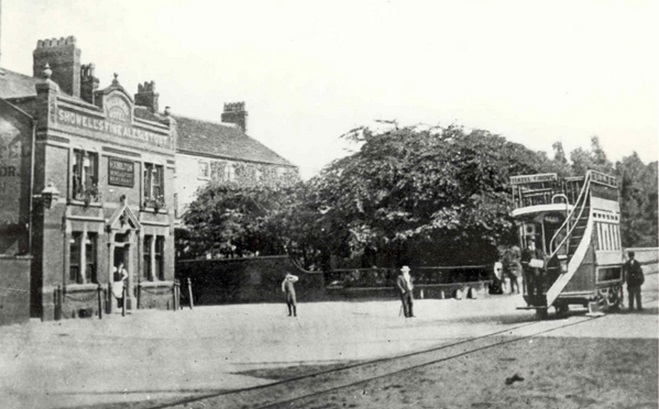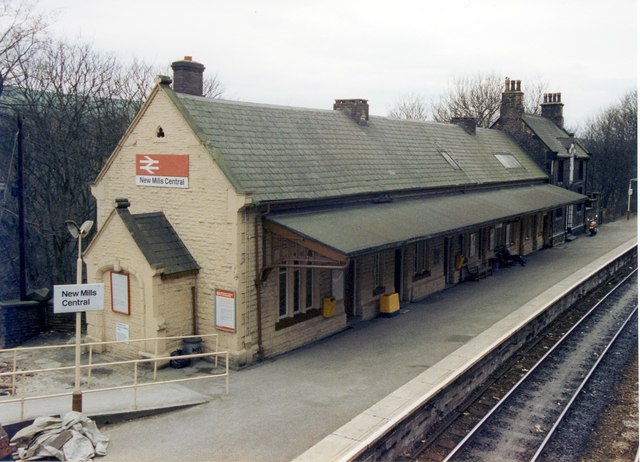|
Hazel Grove Railway Station
Hazel Grove railway station is a junction on both the Stockport to Buxton and Stockport to Sheffield lines, serving the village of Hazel Grove, Greater Manchester, England. History The station was built for the Stockport, Disley and Whaley Bridge Railway, by the London and North Western Railway, and opened on 9 June 1857. From 1923 until 1948, it was owned by the London Midland and Scottish Railway and, following nationalisation, it was operated by the London Midland Region of British Railways. There was once another station in the village, Hazel Grove (Midland) station, on the Midland Railway's line from New Mills South Junction to Manchester Central, via Cheadle Heath; this opened in 1902, but it was less conveniently situated and closed in 1917. The line was extremely expensive to build with extensive earthworks. The navvies were accommodated in specially-built houses near the Rising Sun pub, which still exist and are known as the ''Navvy Mansions''. The line from E ... [...More Info...] [...Related Items...] OR: [Wikipedia] [Google] [Baidu] |
Hazel Grove
Hazel Grove is a suburb in the Metropolitan Borough of Stockport, Greater Manchester, England, close to the Peak District national park. Within the boundaries of the Historic counties of England, historic county of Cheshire, the area was known as Bullock Smithy until 1836. History Early history Hazel Grove is made up of three separate townships: Norbury, Greater Manchester, Norbury, Torkington and Bosden-cum-Handforth. Norbury (Nordberie) was mentioned in the Domesday Survey in 1086. Each of the townships were manorial lands. Until the 17th century, the area was known exclusively by each of the respective townships. In 1560, Richard Bullock built a Forge, smithy on the corner of what is now Torkington Park. This building later became the Bullock Smithy Inn and gradually the whole area became known as Bullock Smithy. Non-conformists There were no churches in the area until the end of the 16th century. The church consisted of a very basic chapel, without Eucharist, communi ... [...More Info...] [...Related Items...] OR: [Wikipedia] [Google] [Baidu] |
British Railways
British Railways (BR), which from 1965 traded as British Rail, was a state-owned company that operated most of the overground rail transport in Great Britain from 1948 to 1997. It was formed from the nationalisation of the Big Four British railway companies, and was privatised in stages between 1994 and 1997. Originally a trading brand of the Railway Executive of the British Transport Commission, it became an independent statutory corporation in January 1963, when it was formally renamed the British Railways Board. The period of nationalisation saw sweeping changes in the railway. A process of dieselisation and electrification took place, and by 1968 steam locomotives had been entirely replaced by diesel and electric traction, except for the Vale of Rheidol Railway (a narrow-gauge tourist line). Passengers replaced freight as the main source of business, and one-third of the network was closed by the Beeching cuts of the 1960s in an effort to reduce rail subsidies. On privatis ... [...More Info...] [...Related Items...] OR: [Wikipedia] [Google] [Baidu] |
Liverpool Lime Street Railway Station
Liverpool Lime Street is a terminus railway station and the main station serving the city centre of Liverpool. Opened in August 1836, it is the oldest still-operating grand terminus mainline station in the world. A branch of the West Coast Main Line from London Euston terminates at the station, as does the original Liverpool and Manchester Railway. Journeys from Lime Street cover a wide range of destinations across England, Scotland and Wales. Having realised that their existing Crown Street railway station was too far away from the city centre, the Liverpool and Manchester Railway commenced construction of the more central Lime Street station in October 1833. Designed by John Cunningham, Arthur Holme and John Foster Jr, it was officially opened in August 1836. Proving to be very popular with train commuters, expansion of the station had become necessary within six years of its opening. The first expansion, which was collaboratively produced by Joseph Locke, Richard Turn ... [...More Info...] [...Related Items...] OR: [Wikipedia] [Google] [Baidu] |
TransPennine Express
TransPennine Express (TPE), legally First TransPennine Express Limited, is a British train operating company owned by FirstGroup that operates the TransPennine Express franchise. It runs regional and inter-city rail services between the major cities and towns of Northern England and Scotland. The franchise operates almost all its services to and through Manchester covering three main routes. The service provides rail links for major towns and cities such as Edinburgh, Glasgow, Liverpool, Sheffield, Hull, Leeds, York, Scarborough, Middlesbrough and Newcastle. TPE run trains 24 hours a day, including through New Year's Eve night. TPE trains run between , and at least every three hours every night of the week. The franchise operates across the West Coast Main Line, Huddersfield Line, East Coast Main Line and part of the Tees Valley line. The majority of TPE's rolling stock was procured during the late 2010s under ''Project Nova''. These consist of the ''Nova 1'' () BMU trainse ... [...More Info...] [...Related Items...] OR: [Wikipedia] [Google] [Baidu] |
East Midlands Railway
Abellio East Midlands Limited, trading as East Midlands Railway (EMR), is a train operating company in England, owned by Abellio, and is the current operator of the East Midlands franchise. History In March 2017, the Department for Transport announced that Arriva, a joint venture between FirstGroup and Trenitalia, and incumbent Stagecoach had been shortlisted to bid for the next East Midlands franchise. Abellio was added in February 2018. FirstGroup and Trenitalia pulled out of the bidding process in April 2018 to focus on the West Coast Partnership franchise. In April 2019 the franchise was awarded to Abellio, with East Midlands Railway (EMR) to take over the franchise from East Midlands Trains (EMT) on 18 August 2019 for a period of eight years. [...More Info...] [...Related Items...] OR: [Wikipedia] [Google] [Baidu] |
New Mills Central Railway Station
New Mills Central railway station serves the town of New Mills in Derbyshire, England. It is on the Hope Valley Line between Manchester Piccadilly and Sheffield, east of the former. The town is also served by New Mills Newtown station, which is on the Buxton to Stockport and Manchester line. History In the mid-19th century, the Manchester, Buxton, Matlock and Midlands Junction Railway ran as far as Rowsley and was extended by the Midland Railway to Buxton, in its aim to run as far as Manchester. The Manchester, Sheffield & Lincolnshire Railway also wished to extend southwards from its main line through Woodhead Tunnel to Sheffield and had built a branch to Hyde. Meanwhile, the London and North Western Railway had constructed their own line to Buxton from Whaley Bridge, with a station at Newtown, which effectively blocked the other two. An agreement was reached whereby the MS&LR would build their proposed "Marple, New Mills and Hayfield Junction Railway", while the Midlan ... [...More Info...] [...Related Items...] OR: [Wikipedia] [Google] [Baidu] |
Romiley Railway Station
Romiley railway station serves Romiley, in the Metropolitan Borough of Stockport, Greater Manchester, England. History It was built by the Manchester, Sheffield and Lincolnshire Railway on its extension to New Mills, opening in 1862 from Manchester London Road. A second route, the Macclesfield, Bollington and Marple Railway to which joined the older line at ''Marple Wharf Junction'', was opened in 1869; this provided links to Macclesfield and Stoke-on-Trent. Facilities The station was built above street level; its platforms extend over the B6104 road. It has a spiral staircase, which once had a glass-roofed dome. The booking hall (staffed 06:20-20:45 weekdays and 07:10-21:35 Saturdays) and offices are on the first floor, with a subway and stairs to the platforms. Ramps are also available for wheelchair users. The station has a long line public address system providing automated announcements and digital information displays to offer train running details (these can also be ... [...More Info...] [...Related Items...] OR: [Wikipedia] [Google] [Baidu] |
Manchester Metrolink
Manchester Metrolink (branded locally simply as Metrolink) is a tram/ light rail system in Greater Manchester, England. The network has 99 stops along of standard-gauge route, making it the most extensive light rail system in the United Kingdom. Metrolink is owned by the public body Transport for Greater Manchester (TfGM) and operated and maintained under contract by a Keolis/ Amey consortium. In 2021/22, 26 million passenger journeys were made on the system. The network consists of eight lines which radiate from Manchester city centre to termini at Altrincham, Ashton-under-Lyne, Bury, East Didsbury, Eccles, Manchester Airport, Rochdale and Trafford Centre. It runs on a mixture of on-street track shared with other traffic; reserved track sections segregated from other traffic, and converted former railway lines. Metrolink is operated by a fleet of 147 high-floor Bombardier M5000 light rail vehicles. Each service runs to a 12-minute headway; stops with more than one serv ... [...More Info...] [...Related Items...] OR: [Wikipedia] [Google] [Baidu] |
Alternating Current
Alternating current (AC) is an electric current which periodically reverses direction and changes its magnitude continuously with time in contrast to direct current (DC) which flows only in one direction. Alternating current is the form in which electric power is delivered to businesses and residences, and it is the form of electrical energy that consumers typically use when they plug kitchen appliances, televisions, fans and electric lamps into a wall socket. A common source of DC power is a battery cell in a flashlight. The abbreviations ''AC'' and ''DC'' are often used to mean simply ''alternating'' and ''direct'', as when they modify ''current'' or ''voltage''. The usual waveform of alternating current in most electric power circuits is a sine wave, whose positive half-period corresponds with positive direction of the current and vice versa. In certain applications, like guitar amplifiers, different waveforms are used, such as triangular waves or square waves. Audio a ... [...More Info...] [...Related Items...] OR: [Wikipedia] [Google] [Baidu] |
Navvy
Navvy, a clipping of navigator ( UK) or navigational engineer ( US), is particularly applied to describe the manual labourers working on major civil engineering projects and occasionally (in North America) to refer to mechanical shovels and earth moving machinery. The term was coined in the late 18th century in Great Britain when numerous canals were being built, which were also sometimes known as "navigations", or "eternal navigations", intended to last forever. Nationalities A study of 19th-century British railway contracts by David Brooke, coinciding with census returns, conclusively demonstrates that the great majority of navvies in Britain were English. He also states that "only the ubiquitous Irish can be regarded as a truly international force in railway construction,"Brooke (1983). Page 167. but the Irish were only about 30% of the navvies. By 1818, high wages in North America attracted many Irish workers to become a major part of the workforce on the construction of the ... [...More Info...] [...Related Items...] OR: [Wikipedia] [Google] [Baidu] |
Cheadle Heath Railway Station
Cheadle Heath railway station was a railway station in Cheadle Heath, Cheshire, England. Construction and opening The station was built on the Midland Railway's New Mills and Heaton Mersey Line (the so-called "Disley cut off" line) to avoid the congestion and junctions of New Mills, Marple, Romiley and Stockport Tiviot Dale and difficult profile of the existing line, slowing down London St Pancras to Manchester Central express trains via the Manchester South District Line. On 1 October 1901, the initial section from Heaton Mersey to Cheadle Heath opened, with a service of passenger trains to Manchester Central. The line through Disley tunnel to New Mills South Junction was opened on 1 July 1902, enabling through services to Derby and other stations. Initially named Cheadle Heath, from 1 May 1902 to 1 October 1908 the name was Cheadle Heath for Stockport, from 1 October 1908 until 14 June 1965 Cheadle Heath Stockport, and from that date until closure the station reverted to ... [...More Info...] [...Related Items...] OR: [Wikipedia] [Google] [Baidu] |


.jpg)



